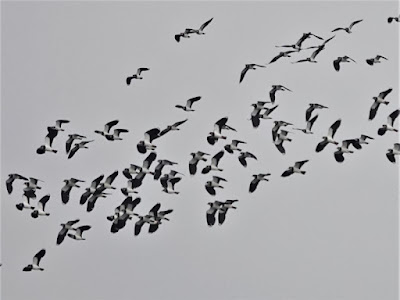Two adult Mute Swans with a cygnet from this year.
I took a poor photo of a Shelduck at Priorslee Balancing Lake last Friday. Here is a better photo of one. This a drake with the large swelling at the base of his bill.
Very smart.
"Don't dribble".
"If I paddle hard I can just reach the vegetation on the bottom".
It must be more shallow here if this pair of Common Teal can reach, the drake on the left.
A drake Shoveler flies by.
And two more, both yet to complete their moult in to breeding plumage.
A drake Eurasian Wigeon. Also not in full breeding plumage with a few retained feather from its juvenile or eclipse plumage worn during last summer.
And a duck Eurasian Wigeon.
A more prosaic species: a duck Mallard flies by. She looks almost to be smiling at me.
Good to see. A large number of Lapwings were present, always jumpy and ready to take to the air at the slightest hint of a nearby predator.
It is surprisingly difficult to take acceptable flying shots of Lapwings as they continually change direction and orientation. Today I was more successful than usual and here is a selection from many, many attempts. Starting with a single bird.
And another.
And again.
A duo.
A trio. The pale fringes to the feathers on the back and wings will soon wear away leaving the birds in their glossy breeding plumage.
A quartet with their crests blowing in the breeze.
A few more.
Close inspection shows there are at least 18 Common Snipe lurking in the grass. In the foreground is another moulting drake Eurasian Wigeon. A duck is hidden in the grass at the left.
Four Common Snipe here.
Five here. The bird second from the left looks smaller. Could it be a Jack Snipe? Sadly not. That species has a solid dark crown. It lacks the pale crown stripe of the Common Snipe which it must therefore be.
If Lapwing are difficult to photograph in flight then snipe have the added challenge that they are very fast-flying. Here one comes in to land. Note the small feathers extending from the middle of the forewing. These are known as alulae and are replicated on aircraft as leading edge slats, both helping with directional control at low speed.
Something spooked the main bulk of them giving me an opportunity to try and photo them in flight. A few attempts start with this quartet.
And another quartet.
Elegant?
A wisp of snipe here. Well 'wisp' is what I have always thought of as the collective noun for this species. Apparently 'walk' is the more usual with 'flight' and 'bevy' along with 'wisp' all being alternatives. 'Wisp' it will stay for me.






























